Baoulé people, Kplè-Kplè Goli mask, Ivory Coast
Pagina 1 di 1
 Baoulé people, Kplè-Kplè Goli mask, Ivory Coast
Baoulé people, Kplè-Kplè Goli mask, Ivory Coast
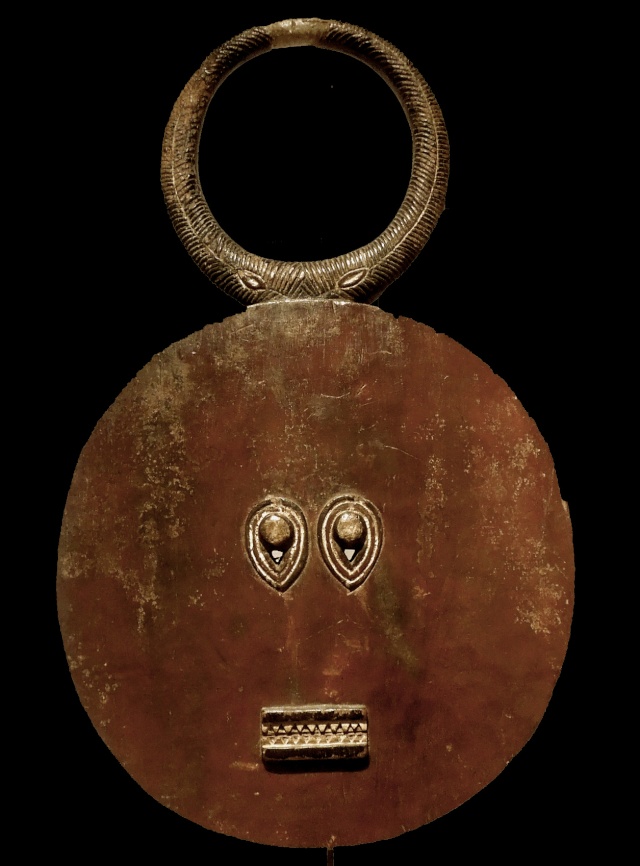
Baoulé people, Kplè-Kplè Goli mask, Ivory Coast
Wood, color pigments, traces of deep use
H.35,4 x 20,9 x 3,1 in / H.90 x 53 x 8 cm
First quarter 20th century
Private collection, Italy
Photo by Alberto Maccacaro
Arti delle Mani Nere All Rights Reserved
Provenance
† Enrico Prometti old collection, Italian Painter and Sculptor
Etnie Gallery, Verona, Italy
Exibition
AKAN. Arte Tradizionale della Costa d’Avorio, Etnie Gallery, Verona, Italy, 20 October / 10 November 2012
Published
Tribal # 65, Autumn, 2012, pag. 24, color

Among the Baule this wood painted mask is known as Goli Kplè-Kplè.
Historically the mask was a late introduction to the Baule who acquired it from the neighboring Wan people sometime around 1900, (the first Kplè-Kplè known is the one included in Henri Labouret’s collection, cited in his article in 1914).
Such a mask appears during ceremonies celebrating the life and death of honoured elders or at other times will dance to simply entertain the village or celebrate the harvest.
The Kplè-Kplè mask was one of a set of masks that appear during a ceremony ( Goli) and is identified with the spirit of the young men who dance the mask. As one of the first masks to appear during a dance ceremony Goli Kplè-Kplè sets the stage and engages the audience and prepares the way for masks that will dance later, Goli Glen, Kplan Pre and Kpan.
The four pairs of masks appear, two by two, in a fixed order. First a pair of Kplè-Kplè, next a pair of Goli Glen, third a pair of horned face masks Kplan Pre, and finally a pair of human faced masks Kpan.
The pair is distinguished by colour; the male mask is painted red and the female mask is painted black (this designation is reversed in some villages).
Baule masks are most often symbolically representative of animals in the Baule pantheon of mythical animals and beings. This Kplè-Kplè shows an abstracted buffalo head in a flat format with slightly protruding eyes and mouth and with the horns projecting upwards.
It would be worn with a raffia (grass) costume attached to the lower section of the mask reaching to below the waist with a grass skirt and other grasses covering the body and legs.
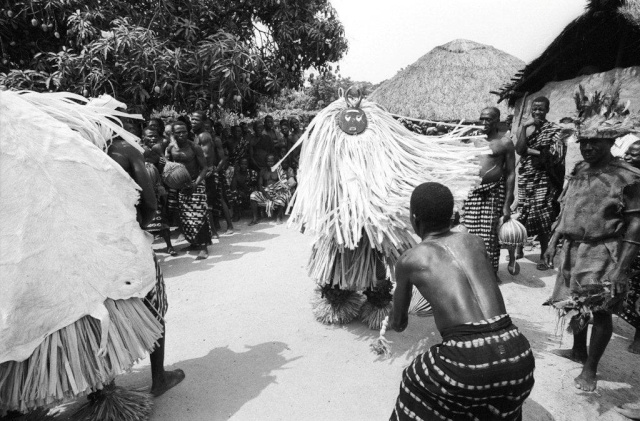
by Eliot Elisofon
“Le Goli présente le monde baoulé dans toute sa complexité , enseigne les grandes divisions- homme et femme, brousse et village, le puissant et le subalterne-et fait également allusion aux unites mystérieuses qui relient ensemble ces elements contradictoires” ( S.M. Vogel, 1999).
As each mask Kplè-Kplè this one has a few sculpture and plastic elements to offer to viewer because of the its absolute stylization.
In this case, however, the perfect balance of form, harmony of proportions, the density of colors which is a "second skin" of the object, the signs of its long use and wear natural wood because of its age , give it unusual intensity of expression and deep, which places it among the most representative examples of this type of masks.
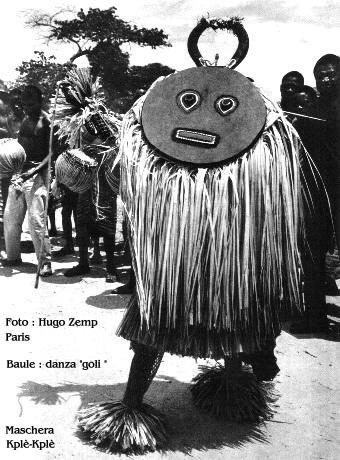
To guide the hand of the artist and the viewer's eye, in this sculpture, are the quality plastic, the simplification of forms, the essence without poverty and the tension between idea and realization.
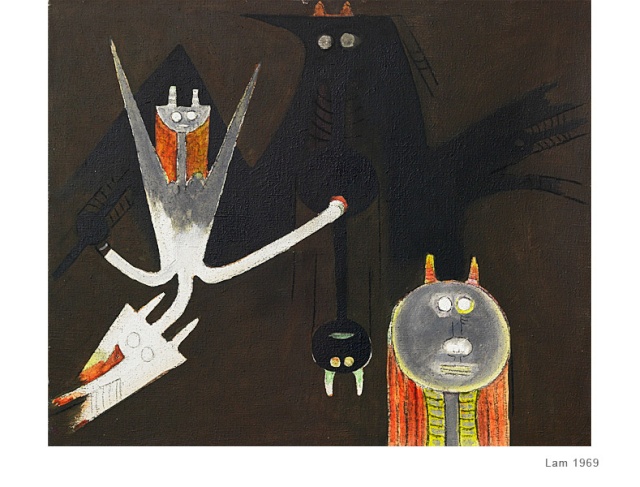
Courtesy Fondazione Passaré, Milano
Bibliography
-Delafosse M. “Sur des traces probabile de civilisation égyptienne et d’hommes de race blanche à la Côte-d’Ivoire”, Paris, L’Anthropologie, n.9, 1900, p. 431-451, 543-568, 677-690
-Labouret, H. "Notes contributatives à l'étude du peuple Baoulé (part II)." Revue d'Ethnographie et de Sociologie, No. 5-6. 1914
-Bordon P. ”Collection des masques d’or Baoule de l'I.F.A.N”. Institut Français d'Afrique Noire Dakar 1948
-Vogel S. “ People of Wood, Baule Figure Sculpture”, 1973, The Art Journal, 33, p. 23-26
-Boyer A.M .”L’Art baoulé, dans Arts de la Côte-d’Ivoire", Textes, tome I, Musée Barbier Mueller 1993, p. 302-367
-Bauloré V. “Les Masques bauolé dans la Côte-d’Ivoire centrale, approches historique et stylistique comparé", Paris-1, UFR 04, décembre 1995
-Vogel S. “ L’Art baoulé du visible et de l’invisible”, Paris, Adam Biro,1999
-Ross D. “Gold of the Akan from the Glassel collection", Houston, The Museum of Fine Arts 2002
-Gottschalk B. “L’art du Continent noir. Du Guimballa aux rives du Congo”, Verlag U. Gottschalk, série< Africa incognita>, Düsseldorf, 2005
-Boyer A.M. "Baule", Milano, 5 Continents Editions, 2008
-Boyer A.M. “Le sacré, le secret. Les Wan. Mona et Koyaka de Côte d'Ivoire,” Genève 2011
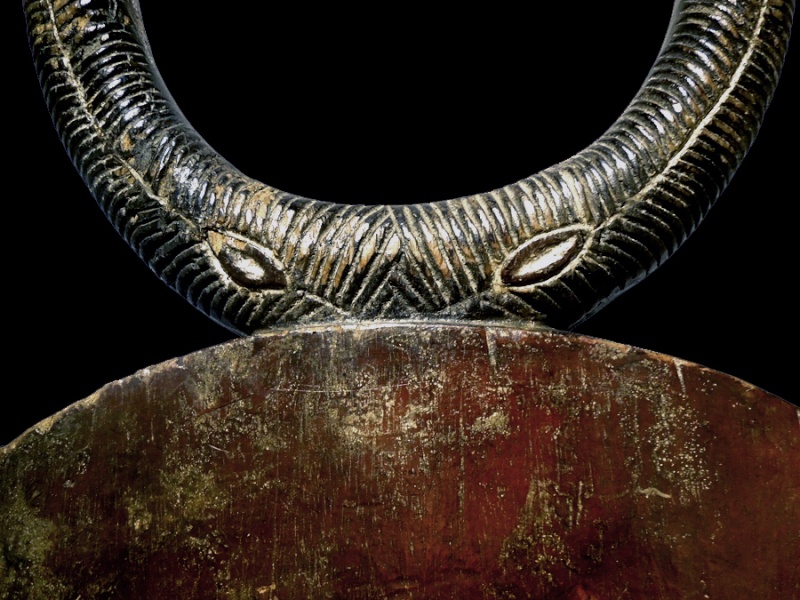
Baoulé people, Kplè-Kplè Goli mask, Ivory Coast
Legno, pigmenti colore, tracce d’uso profondo
H. cm 90 x 53 x 8
Primo quarto XX sec.
Collezione privata, Italia
Foto di Alberto Maccacaro
Arti delle Mani Nere All Rights Reserved
Provenienza
Vecchia collezione † Enrico Prometti, pittore e scultore, Italia
Gall. Etnie, Verona
Esposizioni
AKAN. Arte Tradizionale della Costa d’Avorio, Galleria Etnie,Verona, 20 ottobre/10 novembre 2012

Pubblicazioni
Tribal n. 65, Autunno 2012, pag. 24, color
Tra i Baoulé questa maschera di legno con pigmenti di colore è conosciuta col nome di Goli Kplè-Kplè . Storicamente è dal popolo Wan che i Baoulé hanno acquisito questa maschera agli inizi del XIX sec. (la prima KplèKplè nota è quella della raccolta di Henri Labouret, citata nel suo articolo nel 1914).
Questa maschera appare durante le cerimonie che celebrano la vita e la morte degli insigni anziani o semplicemente in danze per intrattenere il villaggio o celebrare la vendemmia.
La maschera Kplè-Kplè è una di una serie di maschere che appare nel corso della cerimonia Goli e si identifica con lo spirito dei giovani che la indossano danzando.
E’ la prima a comparire, imposta le danze, coinvolge il pubblico e prepara la strada per le maschere che danzeranno successivamente, la Goli Glen, la Kplan Pre e la Kpan.
Le quattro coppie di maschere appaiono due a due in ordine fisso. Prima le Kplè-Kplè, dopo un paio di Goli Glen, terzo le due maschere cornute Kplan Pre ed infine una coppia di maschere umane denominate Kpan.
La coppia si distingue dal colore, la maschera maschile è dipinta di rosso e quella femminile di nero (in alcuni villaggi i colori sono invertiti).
Le maschere Baoulé rappresentano spesso figure di animali e di esseri mitici rappresentativi del loro pantheon.
Questa piatta maschera Kplè-Kplè è la rappresentazione stilizzata della testa del bufalo, con gli occhi e la bocca sporgenti e con le corna rivolte verso l’alto.

La maschera è completata da un costume di raffia attaccato nella sua parte inferiore ed il danzatore indossa un gonnellino di raffia o erba che gli copre il corpo e le gambe.
“Le Goli présente le monde baoulé dans toute sa complexité , enseigne les grandes divisions- homme et femme, brousse et village, le puissant et le subalterne- et fait également allusion aux unites mystérieuses qui relient ensemble ces elements contradictoires” ( S.M. Vogel, 1999).
Come ogni maschera Kplè-Kplè anche questa ha pochi elementi scultorei e plastici da offrire all’osservatore stante la sua assoluta stilizzazione.
In questo caso però, il perfetto equilibrio delle forme, l’armonia delle proporzioni, la densità delle cromie che costituisce una “seconda pelle” dell’oggetto, i segni del suo prolungato utilizzo e dell’usura naturale del legno a causa della sua anzianità, le donano un’intensità espressiva inusuale e profonda, che la colloca tra gli esemplari più rappresentativi di questa tipologia di maschere.
In questa scultura sono la qualità plastica, la semplificazione della forme, l’essenzialità priva di povertà e la tensione tra idea realizzativa ed emozione, a guidare la mano dell'artista e l'occhio dell'osservatore.
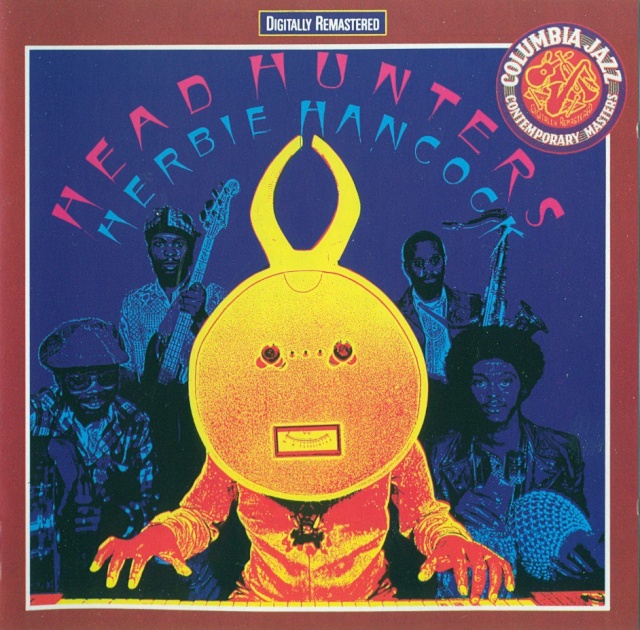
Herbie Hancock, Head Hunters, 1973
Bibliografia
-Delafosse M. “Sur des traces probabile de civilisation égyptienne et d’hommes de race blanche à la Côte-d’Ivoire”, Paris, L’Anthropologie, n.9, 1900, p. 431-451, 543-568, 677-690
-Labouret, H. "Notes contributatives à l'étude du peuple Baoulé (part II)." Revue d'Ethnographie et de Sociologie, No. 5-6. 1914
-Bordon P. ”Collection des masques d’or Baoule de l'I. F. A. N”. Institut Français d'Afrique Noire Dakar 1948
-Vogel S. “People of Wood, Baule Figure Sculpture”, 1973, The Art Journal, 33, p. 23-26
-Boyer A.M .”L’Art baoulé, dans Arts de la Côte-d’Ivoire, Textes, tome I, Musée Barbier Mueller1993, p. 302-367
-Bauloré V. “Les Masques bauolé dans la Côte-d’Ivoire centrale, approches historique et stylistique compare, Paris-1, UFR 04, décembre 1995
-Vogel S. “ L’Art baoulé du visible et de l’invisible”, Paris, Adam Biro, 1999
-Ross D. “Gold of the Akan from the Glassel collection, Houston, The Museum of Fine Arts, 2002
-Gottschalk B. “L’art du Continent noir. Du Guimballa aux rives du Congo”, Verlag U. Gottschalk, série< Africa incognita>, Düsseldorf, 2005
-Boyer A.M " Baule", Milano, 5 Continents, Editions, 2008
-Boyer A.M. “Le sacré, le secret. Les Wan. Mona et Koyaka de Côte d'Ivoire”, Genève 2011
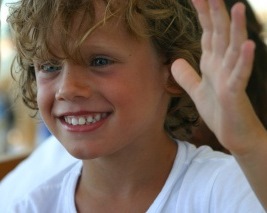
Pietro, quasi cinque anni.
 Argomenti simili
Argomenti simili» Baoulé people, Gold weight, Ivory Coast
» Baoulé people, Gbèkrè, Monkey Figure (Mbotumbo), Ivory Coast
» Senufo people, Kpeli-Yehe mask, Ivory Coast
» Senufo people, Waanyugo (or Waabele), Helmet Mask, Korhogo District, Ivory Coast
» Agni people, Maternity Figure, Ivory Coast
» Baoulé people, Gbèkrè, Monkey Figure (Mbotumbo), Ivory Coast
» Senufo people, Kpeli-Yehe mask, Ivory Coast
» Senufo people, Waanyugo (or Waabele), Helmet Mask, Korhogo District, Ivory Coast
» Agni people, Maternity Figure, Ivory Coast
Pagina 1 di 1
Permessi in questa sezione del forum:
Non puoi rispondere agli argomenti in questo forum.
 Indice
Indice